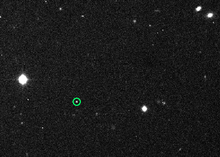 Recovery images of S/2003 J 16 taken by the Canada-France-Hawaii Telescope in September 2010 | |
| Discovery [1] | |
|---|---|
| Discovered by | Brett J. Gladman John J. Kavelaars Jean-Marc Petit Lynne Allen |
| Discovery site | Mauna Kea Obs. |
| Discovery date | 6 February 2003 |
| Orbital characteristics [2] | |
| Epoch 17 December 2020 (JD 2459200.5) | |
| Observation arc | 15.26 yr (5,574 d) |
| 0.1371176 AU (20,512,500 km) | |
| Eccentricity | 0.3330999 |
| –1.64 yr (–600.18 d) | |
| 88.24314° | |
| 0° 35m 59.341s / day | |
| Inclination | 151.16323° (to ecliptic) 28.83677° (retrograde) |
| 83.26365° | |
| 86.51495° | |
| Satellite of | Jupiter |
| Group | Ananke group |
| Physical characteristics | |
| ≈2 km[3] | |
| Albedo | 0.04 (assumed)[3] |
| 23.3[3] | |
| 16.3[2] | |
S/2003 J 16 is a natural satellite of Jupiter. It was discovered by a team of astronomers led by Brett J. Gladman in 2003.[4][1]
S/2003 J 16 is about 2 kilometres in diameter, and orbits Jupiter at an average distance of 0.137 AU (20.5 Gm) in 600 days, at an inclination of 151° to the ecliptic (149° to Jupiter's equator), in a retrograde direction and with an eccentricity of 0.333. It belongs to the Ananke group of retrograde irregular moons which orbit Jupiter between 19.3 and 22.7 Gm, at inclinations of roughly 150°.[3]

This moon was once considered lost[5][3] until September 2010, when it was recovered by Christian Veillet with Canada-France-Hawaii Telescope (CFHT).[6][7] However, the recovery observations of S/2003 J 16 were not reported by the Minor Planet Center until 2020, when Ashton et al. independently identified the moon in the same CFHT images taken by Veillet back in September 2010.[8] S/2003 J 16 was also identified in observations by Scott Sheppard from March 2017 to May 2018, cumulating a long observation arc of 5,574 days (15 years) since its discovery. The recovery of S/2003 J 16 was formally announced by the Minor Planet Center on 4 November 2020.[8][2]
- ^ a b Cite error: The named reference
MPEC-2003-G18was invoked but never defined (see the help page). - ^ a b c Cite error: The named reference
MPEC-2020-V10was invoked but never defined (see the help page). - ^ a b c d e Sheppard, Scott S. (2017). "New Moons of Jupiter Announced in 2017". home.dtm.ciw.edu. Retrieved 27 June 2017.
We likely have all of the lost moons in our new observations from 2017, but to link them back to the remaining lost 2003 objects requires more observations a year later to confirm the linkages, which will not happen until early 2018. ... There are likely a few more new moons as well in our 2017 observations, but we need to reobserve them in 2018 to determine which of the discoveries are new and which are lost 2003 moons.
- ^ IAUC 8116: Satellites of Jupiter and Saturn Archived 2006-05-05 at the Wayback Machine 2003 April (discovery)
- ^ Beatty, Kelly (4 April 2012). "Outer-Planet Moons Found — and Lost". www.skyandtelescope.com. Sky & Telescope. Retrieved 27 June 2017.
- ^ Cite error: The named reference
Jacobson2012was invoked but never defined (see the help page). - ^ Cite error: The named reference
Brozovic2017was invoked but never defined (see the help page). - ^ a b Cite error: The named reference
Ashton2020was invoked but never defined (see the help page).